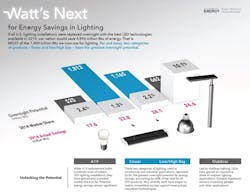DOE releases new research projecting LED lighting adoption in common applications
LED-based lighting was responsible for 143 tBTU in US energy reduction in 2014, although the savings could have hit 4896 tBTU had all general-lighting applications been converted to SSL.
The US Department of Energy (DOE) has released an updated version of its report "Adoption of LEDs in common lighting applications." The report is based on research focused on the adoption of LED technology in ten common general-lighting applications, and also projects what savings could have been with greater penetration of solid-state lighting (SSL) technology. The report documents 143 tBTU (tera or trillion BTUs) in US energy savings in 2014 attributable to LED-based lighting products, although the savings could have hit 4896 tBTU if the country could have converted 100% of the ten applications to SSL. The DOE also just announced additional research funding opportunities.
The new research follows a prior similar report that the DOE issued in 2013. The 2013 savings reported in the earlier report were 71 tBTUs, which was equated to $675M (million) in energy costs at the time.
Interested in more articles & announcements on LED R&D?
The 2015 report equates the 2014 energy savings to $1.4B (billion). The savings, while significant, are the result of only 3% total penetration by LEDs into general lighting. The DOE study found that 36% of all LEDs installed in the US are in A-type applications. But A-lamps don’t offer the energy savings of many of the other nine lighting types covered in the research.
Indeed, the most compelling data is forward looking in other categories. The DOE said that commercial LED lighting applications including linear fixtures and high/low-bay fixtures hold great potential. Those applications have reached only 1.3% and 2.2% penetration, respectively, thus far, yet the commercial usage equating to long hours and high light levels would lead to significant savings as SSL penetrates to a larger degree. And the DOE notes that high-performing products in these applications are poised for escalated usage. The so-called overnight potential of complete conversion in these applications is 1812 tBTU and 1165 tBTU, respectively.
Thus far, directional lighting is the application in which LEDs have made the greatest impact on energy savings. The DOE said the combination of reflector lamps and downlights is responsible for 21% of the energy savings realized in 2014. The linear and low/high-bay applications closely follow in actual 2014 energy savings despite the relatively low penetration rate.
The new report also notes some challenges ahead to broader SSL usage. Specifically, linear fluorescent lighting with state-of-the-art ballasts remains a lower-cost alternative to linear LED lighting. The DOE also said better integration of controls is also needed in applications such as linear and low/high-bay fixtures so that the latest products deliver the maximum potential savings.
You can review both a full copy of the report and a summary on the DOE website.
SBIR/STTR funding
Separately, the DOE has announced the newest research funding opportunities for SSL in the Small Business Innovation Research (SBIR) and Small Business Technology Transfer (STTR) programs. The agency is seeking applications for fiscal year 2016 (FY16) Phase I projects. LED and OLED projects will be considered in areas such as materials that can boost efficiency.
The DOE will hold a webinar on Thursday, July 30, to review potential topics. A second webinar on August 21 will cover the application and award process. Applicants will have to submit a letter of intent by September 8 and full applications are due October 19.
The most recent SBIR/STTR awards came earlier this year in the OLED space. And awards announced in January covered both the LED and OLED space.

Maury Wright | Editor in Chief
Maury Wright is an electronics engineer turned technology journalist, who has focused specifically on the LED & Lighting industry for the past decade. Wright first wrote for LEDs Magazine as a contractor in 2010, and took over as Editor-in-Chief in 2012. He has broad experience in technology areas ranging from microprocessors to digital media to wireless networks that he gained over 30 years in the trade press. Wright has experience running global editorial operations, such as during his tenure as worldwide editorial director of EDN Magazine, and has been instrumental in launching publication websites going back to the earliest days of the Internet. Wright has won numerous industry awards, including multiple ASBPE national awards for B2B journalism excellence, and has received finalist recognition for LEDs Magazine in the FOLIO Eddie Awards. He received a BS in electrical engineering from Auburn University.





